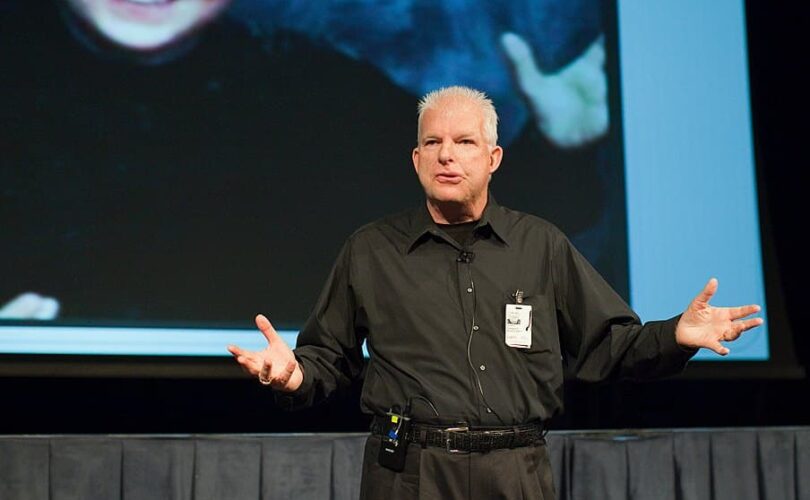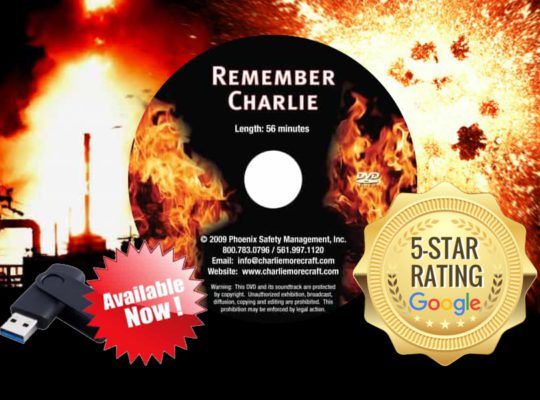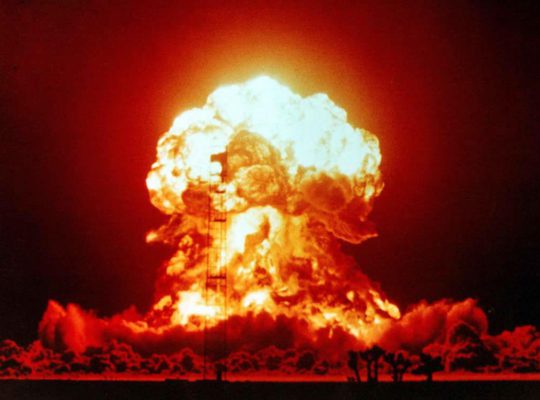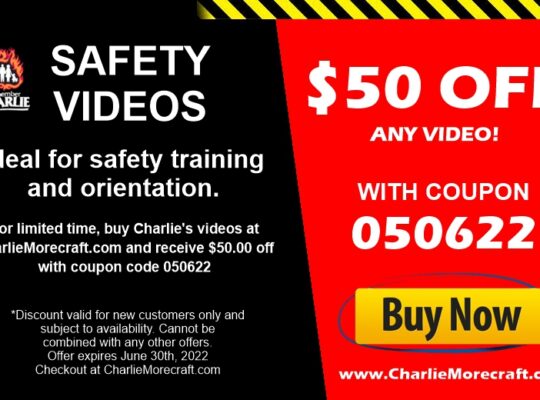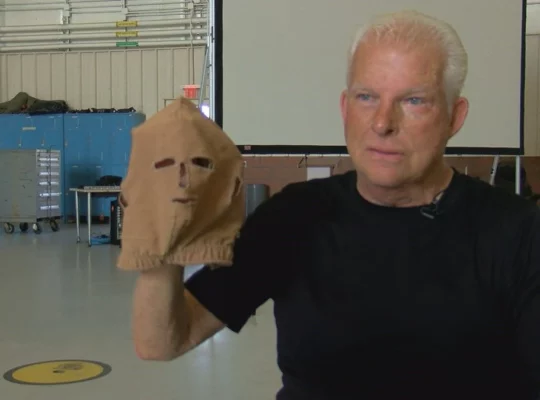About seven years after an explosion at an oil refinery left more than 50 percent of Charlie Morecraft’s body burned, he shared his story to a group of Exxon fellow employees in a work trailer.
Charlie Morecraft worked in an Exxon oil refinery for 27 years. His last position was as an operator, refining raw product into gasoline. He knew the procedures and safety rules, but he usually chose not to follow them. Credit: NASA/Sean Smith.
“Telling them what happened was like lifting a huge weight off my shoulders,” he said. That’s because it was the first time he had told his full story to a group. But it definitely wasn’t the last.
For Morecraft, sharing his experience is therapy. For his audiences, it’s a new outlook on safety and on life. On Monday, Morecraft added NASA Langley to his long list of audiences when he spoke at the kickoff of Safety and Health Awareness Week (SHAW).
“For 15 of the 27 years that I worked at Exxon, I thought, ‘Accidents don’t happen to me, they happen to the other guy,’ ” he said.
His laid-back outlook on safety changed forever on the night before his vacation was planned to begin. While at his desk during a night shift, he received a call to change out a “blank,” a solid piece of metal in the refinery.
“It was a job that I had done 1,000 times before,” he said.
The procedure was time-consuming, and Morecraft decided to take a few shortcuts. He also chose not to wear safety glasses and to roll up the sleeves of his flame retardant suit.
When he heaved the blank out of place, the flammable petroleum product in the line surged up and went into his eyes. He managed to get his vision back and run across the platform and down the stairs. As he ran past the truck he realized that he left it running – something his company’s safety precautions warned against.
“I could see it coming. I could feel it coming,” he said.
And then, he was engulfed in a ball of flames. He saw a puddle ahead and dove into it, putting out the flames. Somehow, he managed to turn off valves and turn on safety equipment.
When emergency personnel arrived, Morecraft didn’t understand their concerned and emotional reactions to seeing him. It wasn’t until he was in the back of an ambulance that he noticed his arms were charcoal black with swelling and blistering.
“That’s when the pain set in,” he said.
Painkillers didn’t help much, and once he was stabilized he was moved to a burn unit where, each day for two months, he was dipped into a stainless steel tank filled with water, Clorox and antibiotics.
“If you ever thought safety equipment was uncomfortable, try wearing a Jobst suit for a year,” Charlie Morecraft said while holding up the mask to the elastic pressure suit that prevented his burn scars from becoming elevated and disfiguring. Credit: NASA/Sean Smith.
“The pain I felt in the ambulance was nothing compared to the pain when they lower you into the tank,” he said.
Morecraft wasn’t alone. “There were 12 other burn victims who said accidents don’t happen to them,” he said. “Nine of them died.”
“When I got back to the room there was no way I could sleep because of the pain, but most of all because I knew that in the morning, I would go back into the tank,” Morecraft said.
Morecraft said he lost count after 20 or 30 operations, including a rebuilt elbow, ears, nose and mouth.
He would share an experience, often followed by the same question: “And for what?”
“Because my safety glasses weren’t comfortable?”
“Because it was too hot to leave my sleeves down?”
“If you ever thought safety equipment was uncomfortable, try wearing a Jobst suit for a year,” he said while holding up the mask to the elastic pressure suit that prevented his burn scars from becoming elevated and disfiguring. When he went into public, he had to carry a card that authorized him to wear the suit that would prompt strange, and sometimes fearful, reactions from others.
Morecraft talked about how his poor choices had negatively impacted his family. “What we do affects the lives of everyone around us,” he said after sharing that his own mom was unable to recognize him in the hospital.
He also shared the stories of others that he met during his recovery. One of his roommates sustained burns from his motorcycle gas tank after an accident. Another man was burned when he lit a match by a gas grill. Another was a college student who was dressed like a mummy for a costume party, when she backed into someone lighting a cigarette.
Paul Roberts beat the odds by making a full recovery from Sudden Cardiac Arrest. He expressed his gratitude for employees and emergency personnel who saved his life, and also stressed the importance of health and preparedness. “It could happen anytime … to anybody,” he said. Credit: NASA/Sean Smith.
“The circumstances are different, but the feelings are exactly the same,” Morecraft said.
That was certainly the case for employees who also shared their experiences and a shake of the hand with Morecraft.
One was Paul Roberts, who collapsed during a work meeting about seven months ago from Sudden Cardiac Arrest. He was dead for seven to 10 minutes before being revived by his coworkers and emergency personnel. Roberts, like Morecraft, thought it wouldn’t happen to him.
“The day before, Nov. 3, I had a physical done by my general practitioner and a great night’s sleep,” Roberts said. “I woke up feeling great that day.”
Even after the incident, doctors told him that his heart was in “fantastic shape.” Roberts’ experience gave him a new outlook. “It could happen anytime … to anybody,” he said.
Another employee who came forward to meet Morecraft, was Glenn Carr, who was in a motorcycle accident that left him in a coma for more than a month. Also, Jerry Kegelman, who in December of 2007 was working on his roof when he fell. His total recovery time was approximately 24 months.
They understood the importance of safety, because after their accidents, they lived to tell about it.
“I lived. If I can leave anything else with you — it is that you have that same opportunity,” Morecraft said.
NASA Langley Research Center
Editor & Curator: Denise Lineberry
Managing Editor: Jim Hodges
Executive Editor & Responsible NASA Official: Keith Henry

